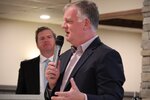By Jane McClure
St. Paul’s five-year streets plan for 2024-2028 has some mixed news for those who walk, bike and drive in the city. While some area projects are penciled in, others continue to face delays. Delays are an ongoing frustration for St. Paul City Council members. Some council members leave office at year’s end with projects still unfinished.
That includes Council President Amy Brendmoen, whose Fifth Ward includes a residential streets project that has been on the maps since 1996. The Wheelock-Grotto project is up for work in 2025-2026. The project area abuts Lake Como and is bounded by Maryland Avenue, Dale Street and Arlington Avenue. It has faced delays over the years.
During a budget review session this fall, Brendmoen reminded St. Paul Public Works Director Sean Kershaw that the city still hasn’t finished rebuilding streets under a residential street reconstruction program approved almost 30 years ago. And now St. Paul is doing mill and overlay work on streets that were rebuilt in the 1980s and 1990s. That includes the Como-Valentine project in St. Anthony Park, which is supposed to have its mill and overlay work finished in early November.
But other streets must wait. Streets in the Wheelock-Grotto area are bowed in some places. Heavy rains send dirt into the lake. That project and other residents street projects have been repeatedly pushed back due to higher construction costs and more demands on the public works budget.
“There are streets that don’t have curbs, that don’t have gutters,” Brendmoen said.
Brendmoen steps down at year’s end without seeing that project completed. The work is now penciled in for 2025-2026. The project has an estimated cost of $8.235 million for 2025, with a $123.6 million price tag in 2026.
Other area neighborhoods’ residents must wait beyond the five-year plan. That includes the Pascal-Como area west of the lake, the Thomas-Aldine area streets and the streets around Seminary-Chatsworth, and a large area bounded by Hamline, University and Western avenues and Interstate 94. Those are tentatively in from 2030 to 2040s. The longest wait may be for the Raymond-Territorial Road area, which has 2050 construction indicated on the map.
St. Paul launched a sewer separation and street reconstruction program in the 1980s after the state of Wisconsin sued over combined sewers and raw sewage being dumped into the Mississippi River. That led to a $300 million program to separate storm and septic sewers, and rebuild city streets.
That work was completed in 1995. It was followed by what was supposed to be a 10-year program to reconstruct the remaining 200 miles of the city’s residential streets.
Council members and city staff discussed the demands on the St. Paul street reconstruction budget in a budget session earlier this fall, and will approve it at year’s end as part of the 2024 budget. Not only have costs risen, the city for many years didn’t do reconstruction on major arterial streets. Now those need a share of the budget.
So, what will happen in area neighborhoods in the next five years, of the plan wins approval at year’s end? Sections of Concordia and St. Anthony avenues will get mill and overlay work, where a street surface is removed and replaced. Crossroads Elementary near Como-Dale-Front will benefit from a Safe Routes to School program in 2025. This will draw on $465,760 in city dollars and $720,000 from the federal government.
Chelsea Heights Elementary, 1557 Huron St., is up for a Safe Routes to Schools project in 2026, with $800,000 from the city and $1 million in federal dollars.
New sidewalks along Marshall Avenue between Snelling Avenue and Albert Street would be supported with $260,000 in municipal state aid and $260,000 in county dollars. Work along Dale Street, Jackson Street, Pennsylvania Avenue and Rice Street in Frogtown are included in later years of the budget as county Public Works projects that the city will share costs in.
How some projects would be funded hinges on the proposed 1 percent sales tax on the Nov. 7 ballot.
The sales tax, if approved, would bring in about $738 million per year for 20 years for street projects, said city engineer Nick Peterson. Projects covered by the sales tax were submitted to the 2023 Minnesota Legislature when approval for the tax was sought.
Some sales tax dollars could be used for mill and overlay work on those streets, Kershaw. That’s because streets are in such poor condition, they cannot wait for full reconstruction.
The later years of the plan are more fluid because additional resources be coming in from various sources. Those are the sales tax and also a state roads and transit tax that started Oct. 1.


Comments
No comments on this item Please log in to comment by clicking here